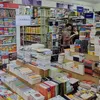70 artists, 180 artworks: Karnataka Chitrakala Parishath showcases the state’s artistic legacy
In our two-part photo essay from this popular Bengaluru art venue, we showcase a range of creative works and curator insights on culture.
Launched in 2014, PhotoSparks is a weekly feature from YourStory, with photographs that celebrate the spirit of creativity and innovation. In the earlier 815 posts, we featured an art festival, cartoon gallery. world music festival, telecom expo, millets fair, climate change expo, wildlife conference, startup festival, Diwali rangoli, and jazz festival.
Karnataka Chitrakala Parishath recently showcased the exhibition titled Timeless Treasures, featuring 180 artworks by 70 artists. See our coverage of earlier exhibitions from the last ten years at this Bengaluru venue here.

“We wanted to do a show to celebrate the senior artists of Karnataka, whose works defined the visual identity of the region in the 20th century,” Dr Vijayashree CS, Curator at the Karnataka Chitrakala Parishath Museum, tells YourStory.
Though these artists have passed away, their contributions have left an enduring legacy.
“They have helped shape Karnataka’s artistic landscape. Karnataka Chitrakala Parishath has always cherished the dream of having a dedicated gallery for the senior artists from Karnataka in its campus. This is the first step in that direction,” Vijayashree describes.
It is clearly difficult to capture the art historical journey for the entire state in one single exhibition. “Hence, we have planned this as a series of exhibitions that will be presented in many volumes,” she adds.

This first volume is titled Timeless Treasures: A Tribute to Artistic Journey. “We have chosen to exhibit the works of artists who are no longer with us and pay respect to their legacy,” Vijayashree says.
“Very rarely does one get to see all these artists under one roof. Of course, the list is extensive, we could not cover all the artists,” she admits.
Forthcoming volumes of the exhibition series will feature other artists. “Sculptures, prints, and other art mediums will also be covered in the next volumes,” Vijayashree says.

The artworks shown are mostly from Karnataka Chitrakala Parishath’s collection. Others are loaned from other institutions.
They include Venkatappa Art Gallery, Government Museum, Karnataka Lalithakala Academy, and Ramsons Mysore. “Many private collectors and artist families also generously shared their works with us,” Vijayashree gratefully acknowledges.
“As a means of self-expression, art gives us voice. It resonates with us, it moves us, it makes us confront the various emotions that are buried within us. I think art gives us all a purpose, a hope,” she affirms.

She also cites the famous quote by Picasso in this regard: The purpose of art is washing the dust of daily life off our souls.
Vijayashree is pleased with the feedback and reception for the exhibition. “The exhibition received a good footfall. Many artists, students, and art lovers were thrilled to see so many works under one roof,” she says.
Artists and admirers came all the way from different parts of Karnataka to see the show. “We have also received some constructive criticism. We will factor in all the responses for our next volumes of the exhibition,” Vijayashree adds.

As trends in Indian art, she feels artists and audiences are moving away from conventional art practices. “Artists are always exploring newer ways to pour out their creative impulses,” she describes.
While there are artists who continue to work in the traditional modes, a new art aesthetic has taken shape in parallel. “Installations, performance art, digital art, NFTs – there are so many things happening simultaneously,” she observes.
“In fact, the influx of AI is opening up new possibilities in the art world. We must wait and see how it will shape up,” Vijayashree signs off.
Now what have you done today to pause in your busy schedule and harness your creative side for a better world?












(All photographs were taken by Madanmohan Rao on location at Karnataka Chitrakala Parishath.)
Edited by Swetha Kannan










